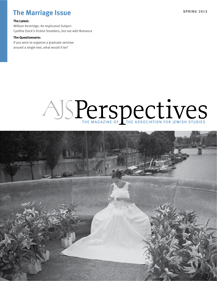Dear Colleagues,
Marriage is always in the news, from the latest tabloid spread to the urgent debate on gay marriage. (Too) much of the policy debate centers around the nature and fate of the seemingly self-evident “Judeo-Christian tradition.” As Jewish Studies scholars, we tend to be skeptical when politicians invoke the tradition we study for a living. High time, then, to collect a representative sample of the latest research on marriage.
The defense of marriage as a biblical institution brings with it no small amount of irony. The Hebrew Bible speaks of men “taking” women; it outlaws marriages with groups deemed too far from Israel and with relatives considered too close; and it stipulates procedures for divorce, remarriage, and verifying adultery. But there are no descriptions of marriage as a convention or representations of wedding rituals. The famous verse in which a man leaves his father and mother in order to cling to a woman might well refer to coitus more than matrimony. The Tanakh describes parties where men drink together prior to whatever transaction affects marriage, yet these feasts lead to confusion and violence. Jacob’s revels end with his marriage to the wrong woman and Samson’s more philosophical symposium leads only to the consummation of war between Judah and the Philistines. For outpourings of love, we must turn to Ruth the Moabite who pledges to her mother-in-law Naomi that “only death will separate me and you” (Ruth 1:17) or to David, who mourns Jonathan in verse, “You were most dear to me. Your love was wonderful to me, more than the love of women” (2 Samuel 26).
The New Testament offers an even bleaker view. Jesus explicitly brings God into the equation and prevents the termination of marriage: “What God has joined together, let no one separate.” Remarriage constitutes “adultery” and the most elevated state is that of the “eunuchs for the sake of the kingdom of heaven” (Matthew 19:6–12). Paul’s famous resolution was “better to marry then to burn” (1 Corinthians 7:9), thus imagining union as a joint policing of desire. Marriage, as articulated here, goes beyond controlling women to assume a mode of Foucauldian self-surveillance in which the individual modulates his desires as part of a larger program of social discipline. Such a program is likewise evident when marriage becomes a metaphor for the relationship between a community and God. Here the actual business of satiation, cohabitation, and reproduction becomes displaced and concealed by yearning, ritual, and expansion of the group of devoted believers. The Bible has much more to say about the marriage between the faithful and God in which the human spouse figures as feminine. Jeremiah speaks of Israel’s tender pursuit of God’s love during the wandering in the wilderness (2:2). But the difficulties inherent in the marriage between God and Israel appear in the book of Ezekiel where God charges His wife with “harlotry,” a “weak heart,” and “filthiness.” After such berating, one almost wishes that God would issue a get rather than “an everlasting covenant” (16). There is debate—much within this issue—over whether the rabbinic marriage contract provides safeguards for women’s basic rights or commodifies brides as objects of transaction. It is certain that rabbinic law establishes marriage as a legal procedure within a public ritual. The implications of the legal procedure and its impacts on Jews from different periods of time lie at the heart of The Marriage Issue. The questions, whether textual or historical, lead us to wonder what to do about marriage today. Some authors suggest that if most women knew what was actually uttered in Aramaic at their weddings, they would never consent.
Others provide ways of transforming marriage and weddings into events that are more inclusive, egalitarian, and true to contemporary values. There are several suggestions about how to contract a halakically legitimate bond while dispensing with some of its objectionable premises. Some articles show that marriage is a contingent affair in which no single bond ever demonstrates the model. Even as scholars agonize over what to do about matrimony in the age of women rabbis and state laws protecting gay marriage, wedding planners and officiants look to Jewish tradition for the telltale huppahs, ketubahs, and smashing of glass. For many couples, the wedding functions as a key moment of connecting to a Jewish past through these signifiers. Should tradition be put aside in the name of progressive values? Without dictating any answers to our current predicament, we recall Naomi Seidman’s article from The Secular Issue that demonstrated how ideas of romantic love entered Jewish thought as a bourgeois nineteenth-century import. Seidman refers to Foucault when she writes of how “the traditional world multiplied rather than constraining sexual relations, embedding its marriages within a dense web of religious, social, and kinship networks.” The bourgeois model, in contrast, separated the couple from these networks eventually turning them into a market that could be expanded through divorce: the greater the number of separate households, the greater consumption of goods and services. If the market replaces God as the driving force of a marriage, then is agency increased? How can one mediate the role of the state when thinking about marriage? How does the case of Israel, where the Rabbinate presides over all state marriages, complicate the issue? Does the institution of marriage afford autonomy? Should it? Can it be transformed and why, to come back to our original question, are we so married to the issue?
Matti Bunzl
University of Illinois Urbana-Champaign
Rachel Havrelock
University of Illinois Chicago

